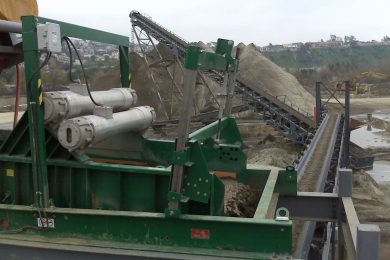South Africa’s water-scarce status hit the headlines with the recent drought, but mines have for many years been confronting the reality of water shortages; and dewatering screens are playing an increasingly vital role in mine water management. According to Kim Schoepflin, CEO of South African vibrating screen and feeder specialist Kwatani, previously known as Joest, mines have adopted various strategies to conserve and recycle water, particularly in their process plants which are often among the most water-intensive operations on site.
“Rather than pumping slurry out into tailings dams – where water is lost through evaporation – mines today will generally aim to get their waste as dry as possible before disposal,” says Schoepflin. “This allows for better recovery of scarce water, while tailings can be disposed of through dry-stacking or as backfill; this both conserves water and protects the environment from water-borne pollution.”
Dewatering vibrating screens add particular value to the commodity being mined, by efficiently extracting recyclable water from the desired end-product to cut transport costs and ensure compliance with sales specifications.
“Excessive water in the end-product makes it expensive to transport and in the case of some commodities penalties are applied,” she says. “There are a number of commodities which have to be dried to a certain degree before they are acceptable to the customer, making dewatering an operational imperative.”
In terms of waste product or tailings, the material must be dry enough to be transported on a conveyor to be stacked.
The dewatering screen drains ‘free moisture’ from a wet slurry through the screen media while retaining as much of the fine particle material in the screen bed, creating a product that can be conveyed and stockpiled with minimal handling and environmental impact. The drained moisture can then be re-used by being recirculated into the processing plant.
The technology works by trapping solid fine particles in a thick layer on the screen, creating a ‘cake’ that acts as a filtration bed. The incoming feed forms a pool in the angle between the back of the screen and the slightly upward sloping deck, where most drainage takes place until the feed particles form a cake.
As the screen vibrates, the G-forces enhance the adherence of the particles to one another, effectively squeezing water out of the material. At the same time, the linear action of the screen conveys the cake up the slightly inclined deck, which on Kwatani dewatering screens can be up to a 5 degree angle.
“Our in-house designed and constructed Kwatani screens achieve higher G-forces by generating an ideal combination of stroke and speed, which in turn squeezes more water out of the bed,” says Schoepflin.
It is also important to retain the material for a sufficient time on the deck of the screen, requiring a more vertical stroke angle and an alignment of the exciter drive’s speed. At the same time, the design must ensure that the required tonnage passes across the deck to suit the mine’s production targets.
Kwatani also offers fine screening solutions by Derrick Corporation, which help mines recover more water and reduce the need to pump slurry onto slimes dams; these dewatering screens can be used as a precursor to thickeners and filter presses. Derrick technology has been successfully used in a number of dewatering applications for mines in a diverse range of commodities worldwide.
Derrick’s HI-G performance, linear motion dewatering screen is able to recover solid material including particles as small as 25 microns. Designed for high volumetric capacity, these screens use two 2,5 horsepower vibrating motors rotating at 1 750 rpm in opposite directions, creating high G-forces. The effectiveness of this solution is enhanced by using very high open area, patented Polyweb urethane screen panels.
“The open area of the screen is critical for successful dewatering, and the high open area of these panels results in a superior dryness of up to 90% solids in the oversize,” says Schoepflin. “The lifespan of these products is lengthened by the urethane panels’ resistance to abrasion. At the same time, the sealed-for-life Derrick vibrators ensure low maintenance operation.”
Tighter environmental controls in most countries across the globe are also a factor behind the trend towards dewatering screens by mining operations, she says, as the ability to extract and treat water from tailings makes it easier for mines to comply with regulations and apply best practice in water management.










